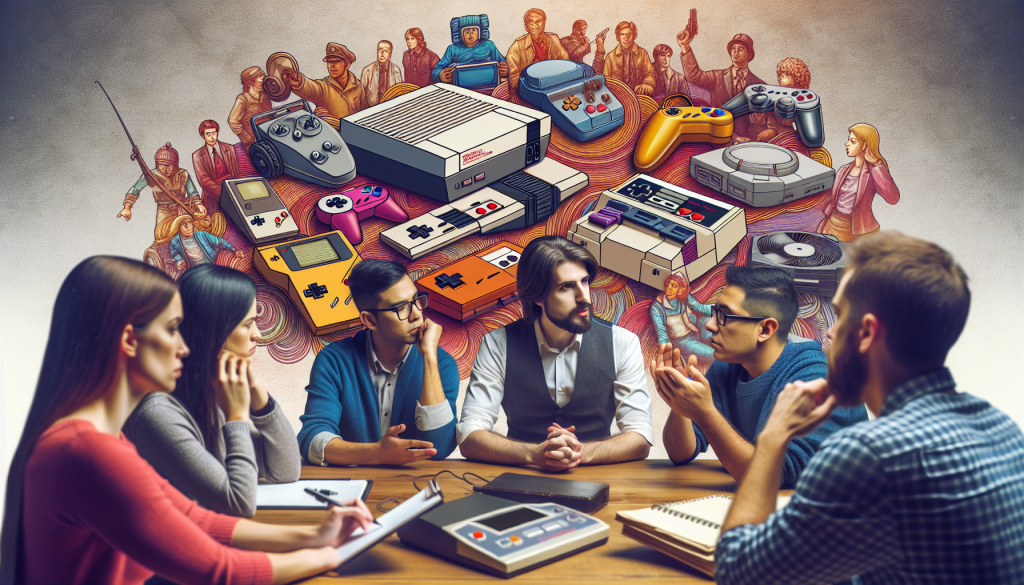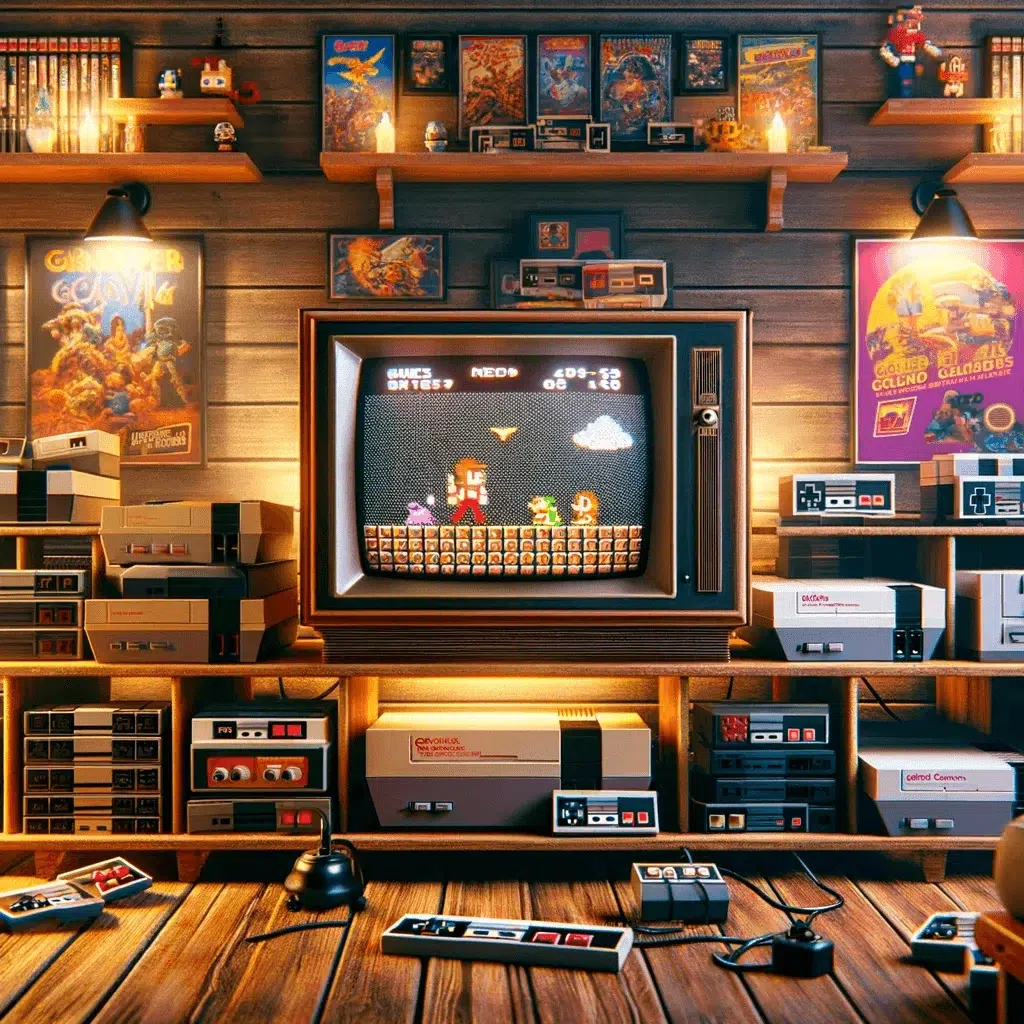The Genesis of Game Controllers: A Look into the Past
So, you’re a fan of video games, huh? Well, who isn’t in this digital era! We all love the thrill of battling monsters on screen or scoring that perfect goal. But have you wondered how that magical device in your hands, the game controller, came into existence? Let’s take a step back in time and explore the fascinating history of game controllers. Buckle up, folks, it’s time for a nostalgic ride!
The Birth of Game Controllers
The journey begins in the 1970s, when the first home video game console, the Magnavox Odyssey, was introduced. It brought with it a simple dial-based controller, which was refreshingly radical at the time. Not much, right? But hey, remember, this was the 70s – a time when video games were just beginning to make an appearance in our living rooms.
Enter Joysticks and D-pads
Fast forward to the 80s, a golden period in the history of gaming. This was when the famous Atari 2600 joystick and the Nintendo Entertainment System (NES) were introduced. The NES controller, with its iconic ‘D-pad’ and ‘A-B’ button layout, became a game-changer (pun intended), inspiring future controller designs.
- Atari 2600 Joystick: This simple stick and single-button controller made games more interactive and enjoyable.
- NES Controller: NES took it a step further with the introduction of the D-pad. This allowed players to control on-screen actions with more precision.
The Shift Towards Ergonomics
As the 90s rolled in, so did the shift towards ergonomics. Sega and Nintendo, two major players in the gaming world, brought out controllers that were designed to fit comfortably in the players’ hands. Sega’s Genesis controller was equipped with three primary buttons and a D-pad, while the Super Nintendo Entertainment System (SNES) controller introduced shoulder buttons for the first time ever!
Introduction of Analogue Sticks
As the millennium approached, Sony changed the game with the introduction of the DualShock controller for the Playstation. This controller featured not one, but two analogue sticks, offering gamers a whole new level of control and precision. The DualShock also boasted a rumble feature, providing haptic feedback for a more immersive gaming experience.
- Sega Genesis Controller: This controller was known for its comfortable grip and easy-to-reach buttons.
- SNES Controller: The introduction of shoulder buttons on the SNES controller paved the way for more complex gaming controls.
- Sony DualShock Controller: Sony set the bar high with the DualShock’s dual analogue sticks and rumble feature.
So, there you have it – a quick tour of the evolution of game controllers from the humble dial-based devices of the 70s to the hi-tech controllers of today. It’s amazing to see how much these indispensable gaming tools have transformed over the years, isn’t it?
Stay tuned as we delve deeper into the world of game controllers in our next post!
Major Technological Advancements in Game Controller Design
Who would have thought that the simple, wired joystick of the 1970s would evolve into today’s sophisticated, wireless game controllers, featuring tactile feedback, motion sensing, and voice recognition! Let’s delve into the exciting journey of these technological advancements.Wireless Controllers: Freedom of Movement
Remember the days when you had to sit close to your game console due to the short wires of your controller? The advent of the wireless game controller revolutionized this scenario. Now, you could game from your cozy couch without the mess of tangled wires. Initially, these controllers used infrared technology, but the modern ones use Bluetooth, enabling a more robust and reliable connection.
Touch and Motion Sensing: A New Way to Play
With the launch of the Nintendo Wii in 2006, the gaming world was introduced to motion control. This extraordinary innovation meant you could swing your controller like a tennis racket or point it like a wand, and the game would respond. This made gaming more interactive and physical.
Moreover, the introduction of touch-sensitive controls added a new dimension to gaming. One iconic example is the rear touchpad of the PlayStation Vita which allowed players to interact with the game in novel ways. Touch controls have since become standard on many handheld devices and mobile games.
Tactile Feedback: Feel the Game
Imagine feeling the recoil of a gun in a shooting game or the vibrations of a car on a rugged terrain in a racing game. That’s what tactile feedback or haptic technology in game controllers made possible. First introduced in the late ’90s as the ‘Rumble Pak’ accessory for the Nintendo 64 controller, this feature has been a game-changer (no pun intended) and is now a must-have in modern game controllers.
Voice and Gesture Recognition: Talk and Wave to Your Game
Next up, we have advancements in voice and gesture recognition, courtesy of technologies like Microsoft’s Kinect. With Kinect, you could control the game using physical gestures and even voice commands. It might not have been perfect, but it signified a massive leap forward in controller design and opened up a whole new avenue for interaction in gaming.
Adaptive Triggers: A New Level of Immersion
The most recent advancement in game controller technology is the introduction of adaptive triggers on the PlayStation 5’s DualSense controller. These triggers can create varying levels of resistance, simulating the sensation of drawing a bow or driving over gravel. It’s a subtle yet powerful feature that further enhances the gaming experience.
These are just a few of the remarkable advancements in game controller technology. While the changes may seem overwhelming at times, they have undeniably enriched our gaming experience, making it more immersive and enjoyable. So grab your controller and get ready for the next level in gaming!
Comparative Analysis: Classic vs Modern Game Controllers
Remember those classic game controllers that used to ignite a sense of joy every time we pressed their buttons? The sheer simplicity of design coupled with the thrill of the game made those times unforgettable. But, as we all know, change is the only constant. So, how does the golden past of game controllers stack up against the technologically advanced present? Let’s dig in and find out.
The Classic Era
If you’re a vintage gamer, you’d know that the Atari 2600 joystick was one of the first game controllers to make a significant impact. It was simple, comfortable, and easy to use.
The Nintendo Entertainment System then ushered in the era of directional pads or D-Pads. The inclusion of ‘start’ and ‘select’ buttons was also a novelty during that time.
- Simple design
- Comfortable for prolonged use
- Easy to use
The Modern Era
Fast forward to the present times, and we’re spoilt for choice. Modern game controllers offer a sensory experience like none other. For instance, the DualShock 4 from PlayStation delivers haptic feedback that gives the player a unique sensation of being in the game.
Xbox controllers, too, have evolved significantly over time, with the Xbox Elite Wireless Controller Series 2 offering customizable components for better gameplay.
- Advanced features like haptic feedback
- Wireless technology
- Customizable components
A Comparative Look
From the basic one-button, one-joystick setup of the Atari 2600 to the multifunction, wireless controllers of today, it’s been a fascinating journey. Classic controllers win hands down when it comes to simplicity. There’s a certain charm in those basic controllers, and they surely evoke a sense of nostalgia.
On the other hand, modern controllers, with their advanced features and ergonomic designs, offer a more immersive experience. It’s not just about playing a game anymore; it’s about living the game.
But as we all know, with great power (read features) comes great complexity. The learning curve for modern controllers can be intimidating for some.
So, in the end, it’s a matter of personal preference. Some may prefer the simplicity and ‘no-frills’ experience of classic controllers, while others may go for the feature-loaded modern ones.
Regardless of your preference, one thing is certain: both classic and modern game controllers have their unique place in the gaming universe. And, as we continue to embrace the future of gaming, it will be interesting to see how game controllers evolve further to enhance our gaming experiences.
The Future of Game Controllers: Innovations and Predicaments
Thinking about the future is always filled with a combination of excitement and uncertainty, and the same goes for the future of game controllers. As we look ahead, we’re faced with an interesting paradox: on one hand, technological advancements are broadening the horizons of what’s possible; on the other hand, these same advancements present a fresh batch of challenges.
Innovations in the Gaming World
When we talk about innovations in game controllers, it’s hard not to get excited. The potential is just mind-boggling. One of the most talked-about advancements is the integration of haptic feedback, which literally allows players to feel the games they’re playing. Imagine feeling the recoil of a virtual gun or the vibrations of a car as you’re racing – it’s all becoming possible with haptic technology.
Then there’s the rise of motion control. Thanks to the likes of Nintendo’s Wii and Microsoft’s Kinect, we’re already familiar with the basics of this technology. But as technology improves, so too will the accuracy and responsiveness of motion control, potentially paving the way for a much more immersive gaming experience.
And let’s not forget the potential of virtual reality (VR) and augmented reality (AR). With VR/AR controllers, we’re not just talking about a new way to control games – we’re talking about a completely new way to experience games. The potential here is nearly limitless!
Challenges Ahead
Of course, with every innovation comes new challenges. And in the case of game controllers, these challenges are both technological and societal.
From a technological standpoint, the biggest challenge is likely to be compatibility. As controllers become more advanced, ensuring they work seamlessly with a wide range of games and platforms will be no easy task. Developers will have to work harder than ever to ensure their games are compatible with an ever-growing array of controller options.
From a societal standpoint, there’s the challenge of accessibility. As game controllers become more complex, there’s a risk of excluding gamers who are unable, or simply unwilling, to keep up with the tech. It’s crucial that the gaming industry remains inclusive and accessible to all, no matter how advanced the technology becomes.
So, while the future of game controllers is undeniably exciting, it’s also filled with challenges. But if history has taught us anything, it’s that the gaming industry is more than up to the task. Bring on the future!













13 thoughts on “Game Controllers: An Evolutionary Journey”
Wow, wonderful weblog format! How lengthy have you ever been blogging for?
you make blogging glance easy. The whole look of your web site is wonderful,
as smartly as the content! You can see similar here
dobry sklep
I wanted to thank you for this great read!! I definitely enjoyed every bit of it. I have got you book-marked to look at new things you post…
Good day! I just want to offer you a huge thumbs up for the great information you have right here on this post. I am coming back to your website for more soon.
Hi, I do think this is a great website. I stumbledupon it 😉 I will return once again since I bookmarked it. Money and freedom is the best way to change, may you be rich and continue to guide other people.
Right here is the perfect webpage for anyone who wishes to understand this topic. You realize a whole lot its almost hard to argue with you (not that I really would want to…HaHa). You certainly put a new spin on a topic that has been discussed for ages. Excellent stuff, just wonderful!
Spot on with this write-up, I seriously believe that this amazing site needs a lot more attention. I’ll probably be back again to read more, thanks for the info!
Oh my goodness! Impressive article dude! Many thanks, However I am experiencing troubles with your RSS. I don’t know the reason why I can’t subscribe to it. Is there anybody else getting similar RSS problems? Anybody who knows the solution will you kindly respond? Thanks!!
Hi, I do believe this is a great website. I stumbledupon it 😉 I am going to revisit yet again since I book-marked it. Money and freedom is the best way to change, may you be rich and continue to help others.
There is certainly a great deal to find out about this issue. I really like all of the points you have made.
I want to to thank you for this fantastic read!! I absolutely loved every little bit of it. I have you book-marked to look at new stuff you post…
This page certainly has all of the information and facts I wanted concerning this subject and didn’t know who to ask.
Good day! I could have sworn I’ve been to this blog before but after browsing through many of the posts I realized it’s new to me. Anyhow, I’m certainly happy I came across it and I’ll be book-marking it and checking back often!
Aw, this was an extremely nice post. Taking the time and actual effort to create a very good article… but what can I say… I put things off a lot and don’t manage to get nearly anything done.